Z77 mITX Round-Up: Five of the Best – MSI, Zotac, ASRock, EVGA and ASUS
by Ian Cutress on December 31, 2012 7:00 AM EST- Posted in
- Motherboards
- MSI
- ASRock
- EVGA
- ZOTAC
- Asus
- Ivy Bridge
- Z77
- mITX
MSI Z77IA-E53 In The Box
In the past, $145 MSRP motherboards used to offer something special – back in the P67 era I remember getting a USB 3.0 front panel device with a motherboard around this price, making the deal all a bit sweeter. In recent months I have noticed a decline in this generosity – whether this is to bolster profit margins or recoup losses due to the global economic situation I am not sure. With a mITX product there is little that could be added to make it beneficial – I would hope that the most expensive mITX boards would come with a full array of SATA cables as a bare minimum, or with a video converter to maintain compatibility with connections not present on the system itself.
In our MSI Z77IA-E53 box, we get:
Driver CD
Manual
Quick Start Guide
Rear IO Shield
Two SATA Cables, Locking
Antenna base + Antenna
There is not much to get excited about unfortunately. The antenna base is not magnetic like the ones found on the ASUS models, leaving obvious room for improvement.
MSI Z77IA-E53 Software
If the BIOS section of a motherboard is currently focusing on interaction, the software side of the package should be focusing on consolidation. When it comes to software, we do not need separate software for the fan controls, for the Ethernet options, for the overclock options, for the power options, and so on. Having everything in one interface reduces cluttering icons on the desktop and start menu in exchange for one or two extra clicks on an interface. It is true that some companies do not care at all for their software, leaving it blank or not updated in several years – MSI have a somewhat mixed approach to the software system.
Starting with the installation disk, while there are no instructions as to what to do, the main command is the ‘Total Installer’ in each menu. For the drivers, we can get everything installed at the click of a button after an options menu comes up for users to deselect unwanted drivers. Similarly for software, except as per our normal testing we disable any installed anti-virus or firewall included in the package.
MSI split their software package across multiple programs in an attempt to cover all the bases.
MSI Control Center
If any piece of the software package sounded like sitting in the Captain’s chair of the Enterprise, then the Control Center has the name down to a tee. Control Center gives several menus including Overclocking, the OC Genie, Green Power (includes fan controls), recording and mobile control.
The overclocking part of CC gives the user access to the basic clock and voltage controls for the CPU, and the voltage controls for the memory. These options are also paired with detailed screens about the features of the motherboard, the CPU and the memory as shown above. If a change is unable to be completed in the OS, the software requests a system reboot to make the change.
The OC Genie part of CC is the automatic overclocking center of the motherboard. One click of it being enabled and the next boot will offer a default overclock based on the system at hand. Rather than the probing OC solution used by ASUS’ Extreme mode or Gigabyte’s Auto Tuning, this calls up a table of reasonably safe OC settings based on the hardware used and implements it. While it may not be the best overclock possible from the kit the user has, it does provide a one button OC.
The Green Power option is one I find particularly interesting, as shown below:
Here we get a basic two point gradient for the fan in terms of temperature against RPM. Whether this is the true fan RPM as a function of the fan profile, or as a PWM value it is unsure. There is no active testing of the fan profiles, so one would assume it works on the assumption that 0-5% power is ~0 RPM and the RPM value rises linearly with power (i.e. the wrong way to assume fan profiles). Nevertheless, I like the fact that the software plots the current fan speed as a function of time – this allows the user to see the course the fan takes based on load. What would be good is if this bit of software also had an option to apply load to allow the user to see the differentiation.
The recording section is a rather well laid out bit of software that automatically plots any temperature sensor, fan sensor, voltage or CPU utilization against time, along with options to define warning limitations.
The Mobile Control menu is something we are seeing more of from the motherboard manufacturers – letting users adjust settings on the fly via their mobile device or tablet.
Teaming Genie
MSI are a big fan of link aggregation – i.e. using two compatible NICs to act as a single connection. While this will not speed up your internet speed, it may allow a user to speed up file transfer over a network when dealing with two hosts, or if the machine is on a 10 GbE network. There are clearly possibilities in the SOHO NAS arena, although with the Z77IA-E53 we are limited to a single Realtek NIC to begin with. Users wanting to take advantage of Teaming Genie will need to purchase a PCIe NIC add-in card.
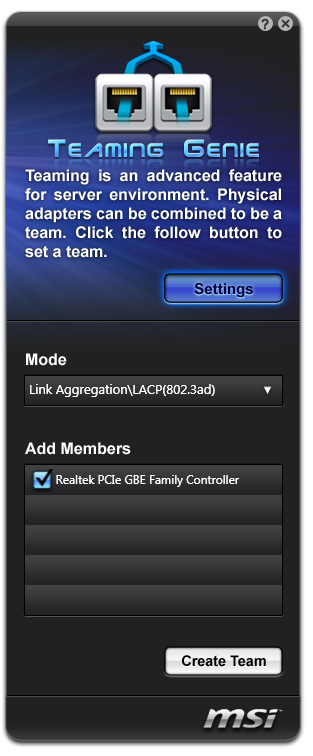
Live Update 5
Every motherboard in this modern area should be bundled with software that allows it to check with online servers for updates. It seems a simple idea in principle – allow the users to have the best up-to-date experience with their hardware to take advantage of updates. This has become the de-facto standard in the graphics card area, with both AMD and NVIDIA building in update systems for their drivers - but yet very few motherboard manufacturers actually do this. MSI do, in the form of Live Update 5.
This software does a scan of the local drivers, the BIOS on the motherboard, and software present. It correlates this to the online database at MSI, and then offers potential downloads. All the options can be downloaded and installed at the click of a button under Total Installer, making the processes almost painless. The only malady with this approach is that MSI fail to tell the user how big these updates are going to be – meaning if you have to download 150 MB of audio codec, you will only be able to tell with guess work. A minor update will make Live Update 5.1 a little easier to handle.
MSI Suite
In order to get the best of MSI software, we have the option to install MSI Suite. This gives the user a small drop down menu on the desktop filled with MSI relevant icons to the other software installed. It is a neat idea, if a little invasive on normal usage. The best bit is that it essentially keeps tabs on Live Update for you, telling when updates are available. There are perhaps better ways to offer these options, but it is something that no other manufacturer is doing.
Easy Viewer
Are you fed up of the basic Windows image viewer? No, me neither. Though MSI have decided it needs a bit of an upgrade, and provide users with Easy Viewer as shown below.
There are basic options for rotation, resizing, brightness and so forth. Personally I actually use FastStone Image Viewer (one of the benchmarks in our testing methodology) which does this a lot better and is a free download.
Click BIOS
Most motherboard manufacturers are aware that the BIOS is actually a seldom used interface in the majority of systems. While enthusiasts are likely to go around and probe the options, or the odd gamer wanting a bit more performance, the majority of users will not know that it exists. I would only just about trust my father or brother to modify their BIOSes correctly, but only because they have been trained.
MSI have decided it is time to bring the BIOS to the user, rather than the other way around. By having some official looking software that can alter the BIOS options, as well as look like the BIOS, it can offer the potential to feel safer than modifying the BIOS directly. Enthusiasts may disagree, but MSI is not targeting enthusiasts with Click BIOS – they are targeting people like my father or brother.
Other software included in the disk comes by the name of Super-Charger (quick USB charging utility) and Network Genie (the Realtek NIC management software with an MSI skin).


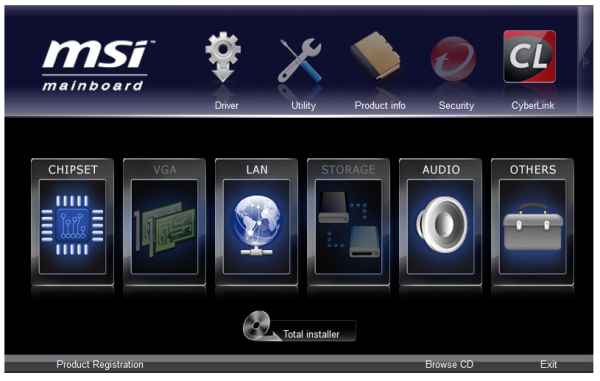
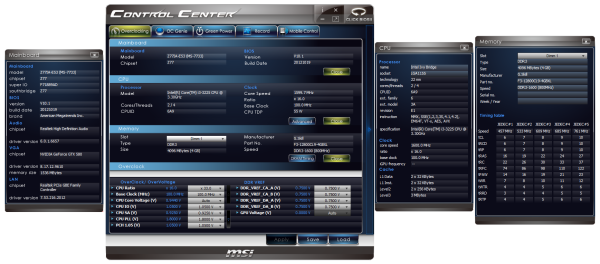
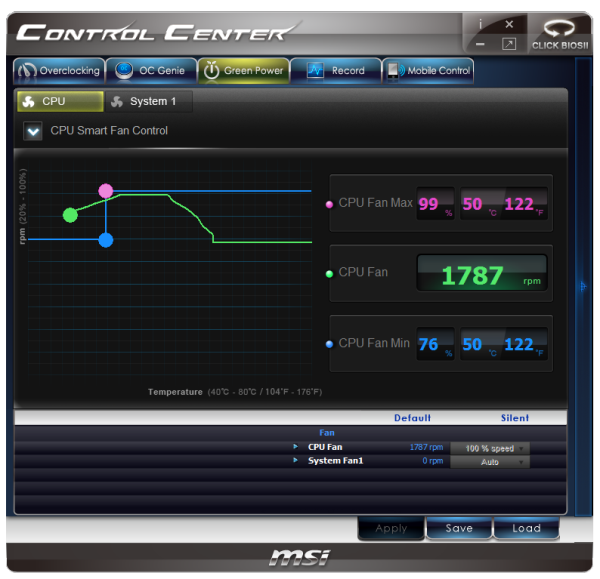
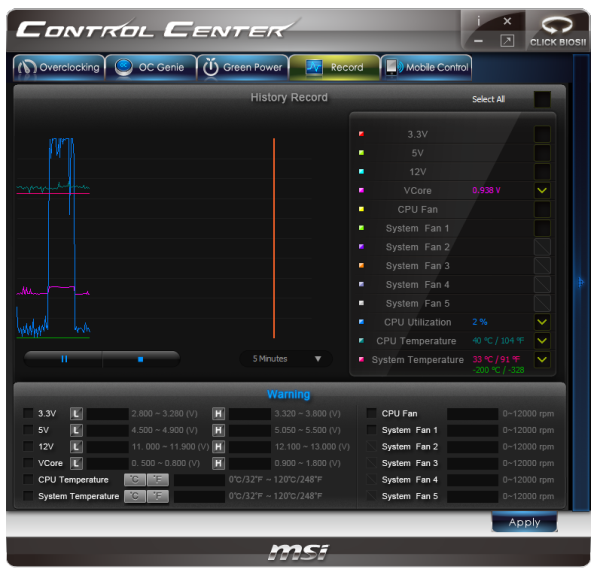
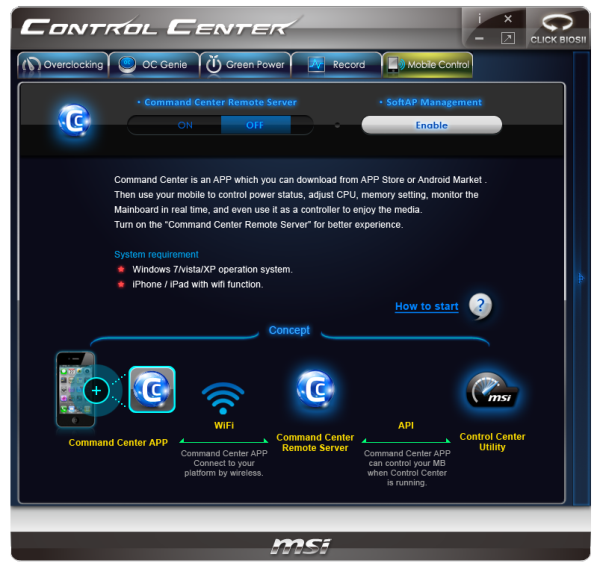


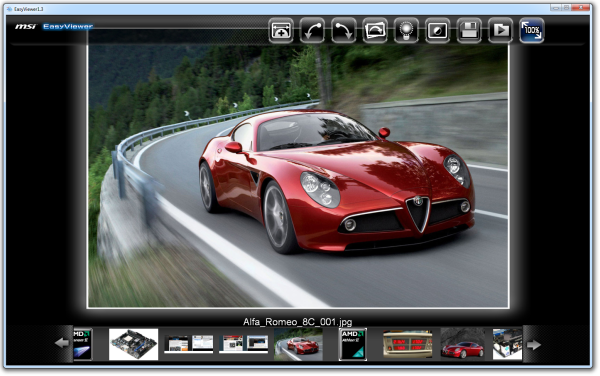















54 Comments
View All Comments
mike_b - Monday, December 31, 2012 - link
Interesting article, but I have to ask why would someone spend more for a Z77 chipset when using 'just' an i3? Surely a much cheaper H61 chipset could do the job admirably, and at much lower cost.Z77 makes sense if you're overclocking, which is excluded from this test...
IanCutress - Monday, December 31, 2012 - link
H61 has no chipset USB 3.0, no chipset SATA 6 Gbps, and you are limited to PCIe 2.0. H61 is also technically limited to one single sided DIMM per channel, and no SATA RAID. There's also SRT to consider, that would be advantageous with the ASRock and the mSATA on the rear.Ian
mike_b - Monday, December 31, 2012 - link
It might make an interesting comparison to see what net advantage is gained with the added features of the Z77 chipset compared with the H61. If budgets are limited the ~100 dollar cost difference between the Z77 and H61 mainboards makes a big difference; that money saved could be put into something which makes more of a performance difference (SSD rather than HDD for example).Anandtech is one of the best tech sites around, you guys do a great job. I do sometimes see though an emphasis on more expensive products when in terms of real-world performance you could get almost the same thing at a much cheaper price. Might be worth mentioning somewhere.
Not least because with yet another new socket coming with Haswell all these 1155 boards will be seen as out of date soon anyway.
IanCutress - Monday, December 31, 2012 - link
Once we get into the swing with Haswell, we will hopefully covering the whole spectrum. Though it is worth noting that motherboard manufacturers, want to put their best foot forward, and would prefer their halo/channel boards get covered before their OEM / low end offerings. Hence this is why you rarely see many mainstream reviews that are not from forums dedicated to the market segment and users testing their own equipment. We are hoping to rectify the balance in due course. If there are any specific products you might want us to test or examine, drop me an email and I'll see what I can put in my schedule (as full as it is[!]) :)Ian
StormyParis - Monday, December 31, 2012 - link
This is a major issue, not limited to motherboards: whenever I'm looking for something middle of the road or outright cheap, I can't find reviews.These Z77 MBs are a nice example: even though I'm recommending/building PCs regularly, most of them mini-ITX, I never came across a use case for Z77. Nobody apart from teens that still have something to prove overclocks anymore. People who want to do multi-GPU get a big case, and a big board. Are we supposed the extrapolate that the makers of good Z77 boards also make good H77 and H61 boards ?
I understand you've got to make do with what you're given by the OEMs. And that reviews was very good, as usual. Pity it is irrelevant ?
Tech-Curious - Monday, December 31, 2012 - link
That's an interesting observation. I have to say, I never noticed a significant lack of coverage for low-to-mid-range components (either in general or on Anandtech in particular), until this Fall, when I was in the market for a lower end motherboard.I guess I just always gravitated to higher end mobos before. Or maybe the coverage for such products was more comprehensive years ago. My memory's foggy, so it's hard to say.
In any case, motherboards appear to be the exception. If anything, I think the internet has generally grown more bullish on low-to-mid-range CPUs and GPUs in recent years (probably, in part, as a result of the stagnating console situation, which results in stagnating system requirements for games).
But all of that rambling aside, yeah. It'd be nice to see more diverse motherboard analysis. When I bought a b75 a couple of months ago, I literally couldn't find a review for that chipset. It wasn't a big deal; it's not like b75's features are any great mystery, after all -- but it is a little nettlesome to trip over sixty bajillion z77 reviews when there's nary peep about any other chipset.
In other news, Ian's review is a good one -- and given that I've been a faithful user of Asus motherboards for the last 15 years, it's nice to see them take home the prize. :)
Etern205 - Saturday, January 5, 2013 - link
My guess would be, why review a cheap board when majority of the readers here won't even bother buying it?And as for Asus boards, I've heard, they do something called based-line features. This means all boards from the bottom of the range to the top (Intel B75-Z77) will have the same base-line features, other features are just added like BT, WiFi, extra lan, etc.
Tech-Curious - Wednesday, January 9, 2013 - link
Yes, I think the issue is that (at least with respect to Intel chipsets) low-end motherboards don't support overclocking. So they're both less interesting to review (fewer measurable differences in performance among different models), and they're less appealing to the presumed audience of sites like Anandtech.Still, the B75 is a perfectly good chipset. If you aren't heavily invested in overclocking, z77's advantages are likely wasted on you. Personally, I'm well beyond my overclocking days; I just don't have the time or the patience to go through the almost endless tuning process anymore. (Even if you find a stable OC at the outset, it can become unstable later, and/or a given application might expose instability that stress testing didn't, weeks or even months down the road).
jonjonjonj - Friday, January 4, 2013 - link
just cause you don't overclock doesn't mean other people don't. why wouldn't you? because you want to get the fastest cpu that you can afford means you have something to prove? some people are just idiots.Zap - Monday, December 31, 2012 - link
But there isn't a $100 difference between H61 and Z77. There is a cheaper Gigabyte Z77 ITX board that's only around $60 more than the cheapest H61 ITX board, and it was even on sale recently for another $13 off making it less than $50 difference.Alternately one can go the H77 ITX route and get all the Z77 goodies except for overclocking, for around $30 less than the cheapest Z77 ITX. I think $30 more than H61 is reasonable for those extra features, plus guaranteed out-of-the-box BIOS support for Ivy Bridge.
I do agree with your (mike_b) first post regarding the choice of CPU used. Ian Cutress, didn't you have a spare K CPU laying around? There are so many people building overclocked ITX rigs these days. I did in a Silverstone SG05 with low profile air cooler to hit 4.2GHz. Plenty of others use the Bitfenix Prodigy and liquid cooling to hit clocks normally reserved for ATX rigs. Another review site (Tweaktown) tested overclocking on Z77 ITX boards and the ASRock hit near 4.8GHz. THAT'S what I want to see.
Of course this AnandTech roundup has some very useful information too, such as DPC latency tests and POST times. Keep up the good work there! But please, know your audience. Next time if the board is supposed to be overclockable, test that feature.
Maybe there can be a companion article about overclocking and heatsink clearance? Would be a shame to not overclock this nice collection of Z77 ITX boards.